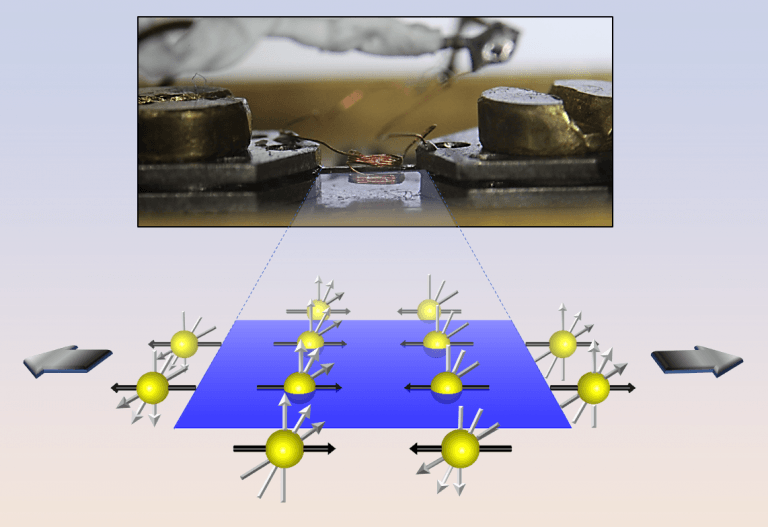Mar 29 2018
The uses of piezoelectric materials, which produce an electric current while being stretched or compressed, are widespread and well known: for instance, they are used in lighters that spark upon pressing a switch, and also in motors, sensors, microphones, and various other types of devices.
At present, a team of physicists has discovered a material that has similar characteristics, except magnetism. The new “piezomagnetic” material has the ability to modify its magnetic characteristics when mechanical strain acts on it.
 Top: A piece of BaFe2As2 is stretched while magnetic measurements are taken (the copper wire coil is part of the NMR device). Lower diagram shows atoms in a plane, with black arrows showing how magnetic spins lie in plane and point in opposite directions. Grey arrows show how the magnetic spin of atoms shifts as the material is stretched. (Image credit: UCDavis)
Top: A piece of BaFe2As2 is stretched while magnetic measurements are taken (the copper wire coil is part of the NMR device). Lower diagram shows atoms in a plane, with black arrows showing how magnetic spins lie in plane and point in opposite directions. Grey arrows show how the magnetic spin of atoms shifts as the material is stretched. (Image credit: UCDavis)
“Piezomagnetic materials are rarely found in nature, as far as I’m aware,” stated Nicholas Curro, professor of physics at UC Davis, who is the senior author of the paper describing the study, published in the Nature Communications journal on March 13, 2018.
Curro and his team were analyzing a barium-iron-arsenic compound, BaFe2As2, which when doped with trace amounts of other elements has the ability to function as a superconductor at temperatures of close to 25 K. This kind of iron-based superconductor is intriguing because, despite the fact that it has to be maintained at very low temperatures to enable it to work, it can be stretched into cables or wires.
BaFe2As2 is called as a “nematic” crystal as its structure experiences a phase transition before achieving superconductivity. The crystal structure of BaFe2As2 transforms from a square configuration to a rectangular one.
Curro along with Tanat Kissikov and Matthew Lawson, graduate students, was making efforts to analyze the material by using nuclear magnetic resonance (NMR) imaging by stretching it, to check whether it could be forced to take up the rectangular configuration. Astonishingly, the magnetic characteristics of BaFe2As2 got modified once it was stretched.
The material is not a bulk magnet; it is an antiferromagnet as the spins of its atoms point in alternating, opposing directions. However, the team found out that the direction of the magnetic spins gets modified in an evaluable manner upon being subjected to stress.
“The real surprise is that it appears that the direction of magnetism can change and come out of plane,” stated Curro.
According to Curro, at present, there is a lack of theory for explaining these outcomes. Research is being conducted in his lab to investigate whether other materials can exhibit the same behavior and whether the mechanical strain has any impact on the superconducting characteristics of the material. (The experiments were not conducted at temperatures at which BaFe2As2 behaved like a superconductor.)
Curro stated that the findings could be applied in innovative ways to investigate strain inside materials such as aircraft components.
Rajib Sarkar, Institute for Solid State Physics, Dresden; Blaine Bush, UC Davis; Erik Timmons, Makariy Tanatar, Ruslan Prozorov, Sergey Bud’ko, and Paul Canfield, Ames Laboratory, U.S. Department of Energy and Iowa State University; and R. M. Fernandes, University of Minnesota, Minneapolis were the other coauthors of the paper. NSF and the U.S. Department of Energy Office of Science supported the study. The Ames Laboratory is operated for the U.S. Department of Energy by Iowa State University.